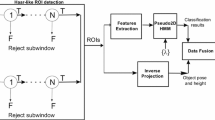Abstract
This paper presents a robust and real-time method for people detection in urban and crowed environments. Unlike other conventional methods which either focus on single features or compute multiple and independent classifiers specialized in a particular feature space, the proposed approach creates a synergic combination of appearance and depth cues in a unique classifier. The core of our method is a Boosted Random Ferns classifier that selects automatically the most discriminative local binary features for both the appearance and depth image spaces. Based on this classifier, a fast and robust people detector which maintains high detection rates in spite of environmental changes is created.
The proposed method has been validated in a challenging RGB-D database of people in urban scenarios and has shown that outperforms state-of-the-art approaches in spite of the difficult environment conditions. As a result, this method is of special interest for real-time robotic applications where people detection is a key matter, such as human-robot interaction or safe navigation of mobile robots for example.
Access this chapter
Tax calculation will be finalised at checkout
Purchases are for personal use only
Preview
Unable to display preview. Download preview PDF.
Similar content being viewed by others
References
Dalal, N., Triggs, B.: Histograms of oriented gradients for human detection. In: Proceedings - 2005 IEEE Computer Society Conference on Computer Vision and Pattern Recognition, CVPR 2005, vol. I, pp. 886–893 (2005)
Dollár, P., Wojek, C., Schiele, B., Perona, P.: Pedestrian detection: an evaluation of the state of the art. IEEE Transactions on Pattern Analysis and Machine Intelligence 34(4), 743–761 (2012)
Enzweiler, M., Gavrila, D.M.: Monocular pedestrian detection: Survey and experiments. IEEE Transactions on Pattern Analysis and Machine Intelligence 31, 2179–2195 (2009)
Enzweiler, M., Gavrila, D.M.: A multilevel mixture-of-experts framework for pedestrian classification. IEEE Transactions on Image Processing 20, 2967–2979 (2011)
Gandhi, T., Trivedi, M.M.: Pedestrian protection systems: Issues, survey, and challenges. IEEE Transactions on Intelligent Transportation Systems 8, 413–430 (2007)
Gerónimo, D., López, A.M., Sappa, A.D., Graf, T.: Survey of pedestrian detection for advanced driver assistance systems. IEEE Transactions on Pattern Analysis and Machine Intelligence 32, 1239–1258 (2010)
Guo, L., Wang, R.B., Jin, L.S., Li, L.H., Yang, L.: Algorithm study for pedestrian detection based on monocular vision. In: 2006 IEEE International Conference on Vehicular Electronics and Safety, ICVES, pp. 83–87 (2006)
Luber, M., Spinello, L., Arras, K.O.: People tracking in RGB-D data with on-line boosted target models. In: IEEE International Conference on Intelligent Robots and Systems, pp. 3844–3849 (2011)
Luber, M., Spinello, L., Arras, K.O.: RGB-D People Dataset. annotated people and tracks in rgb-d kinect data (2011). http://www2.informatik.uni-freiburg.de/spinello/RGBD-dataset.html (accessed September 30, 2014)
Özuysal, M., Fua, P., Lepetit, V.: Fast keypoint recognition in ten lines of code. In: IEEE Conference on Computer Vision and Pattern Recognition (2007)
Porikli, F., Davis, L., Hussein, M.: A Comprehensive Evaluation Framework and a Comparative Study for Human Detectors. IEEE Transactions on Intelligent Transportation Systems 10, 417–427 (2009)
Schapire, R.E., Singer, Y.: Improved boosting algorithms using confidence-rated predictions. Machine Learning 37, 297–336 (1999)
Spinello, L., Arras, K.O.: People detection in RGB-D data. In: IEEE International Conference on Intelligent Robots and Systems, pp. 3838–3843 (2011)
Spinello, L., Arras, K.O.: Leveraging RGB-D data: adaptive fusion and domain adaptation for object detection. In: IEEE International Conference on Robotics & Automation, pp. 4469–4474, May 2012
Villamizar, M., Andrade-Cetto, J., Sanfeliu, A., Moreno-Noguer, F.: Bootstrapping Boosted Random Ferns for discriminative and efficient object classification. Pattern Recognition 45(9), 3141–3153 (2012)
Villamizar, M., Moreno-Noguer, F., Andrade-Cetto, J., Sanfeliu, A.: Efficient rotation invariant object detection using boosted random ferns. In: Proceedings of the IEEE Computer Society Conference on Computer Vision and Pattern Recognition, pp. 1038–1045 (2010)
Villamizar, M., Moreno-Noguer, F., Andrade-Cetto, J., Sanfeliu, A.: Shared random ferns for efficient detection of multiple categories. In: International Conference on Pattern Recognition (ICPR), pp. 2–5 (2010)
Author information
Authors and Affiliations
Corresponding author
Editor information
Editors and Affiliations
Rights and permissions
Copyright information
© 2016 Springer International Publishing Switzerland
About this paper
Cite this paper
Vaquero, V., Villamizar, M., Sanfeliu, A. (2016). Real Time People Detection Combining Appearance and Depth Image Spaces Using Boosted Random Ferns. In: Reis, L., Moreira, A., Lima, P., Montano, L., Muñoz-Martinez, V. (eds) Robot 2015: Second Iberian Robotics Conference. Advances in Intelligent Systems and Computing, vol 418. Springer, Cham. https://doi.org/10.1007/978-3-319-27149-1_45
Download citation
DOI: https://doi.org/10.1007/978-3-319-27149-1_45
Published:
Publisher Name: Springer, Cham
Print ISBN: 978-3-319-27148-4
Online ISBN: 978-3-319-27149-1
eBook Packages: Computer ScienceComputer Science (R0)




